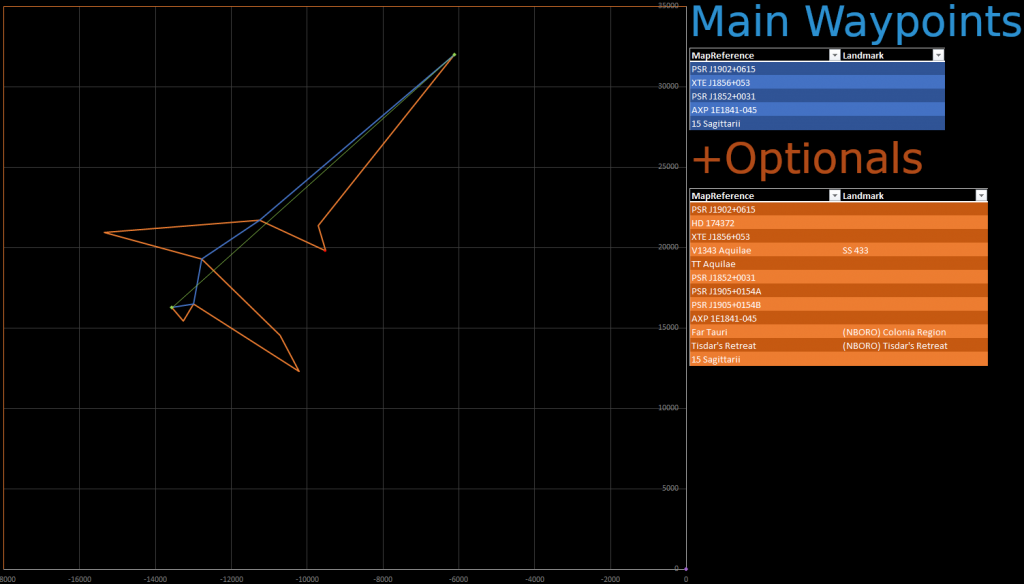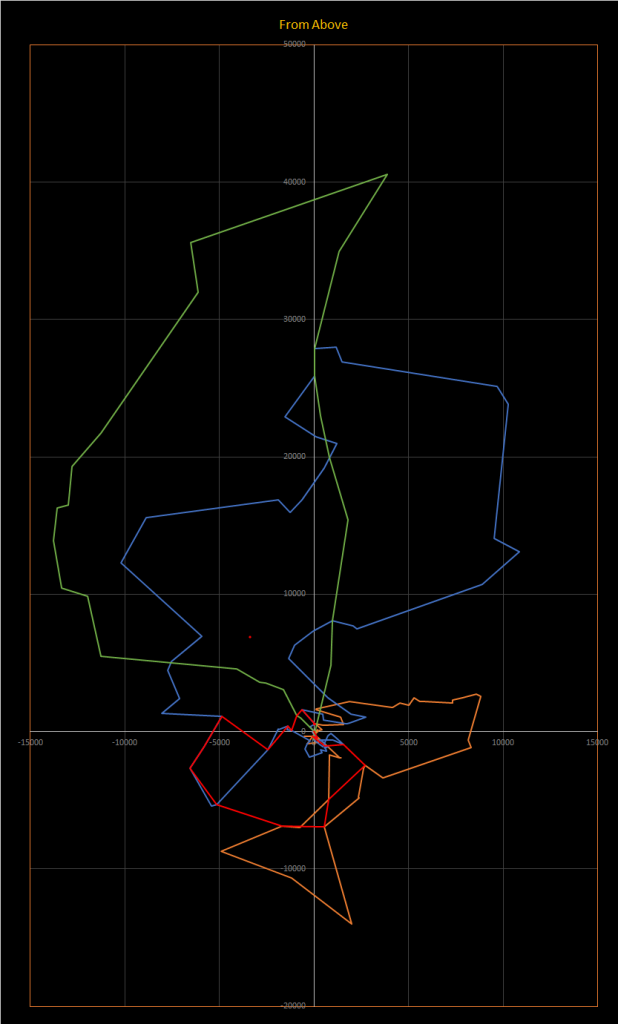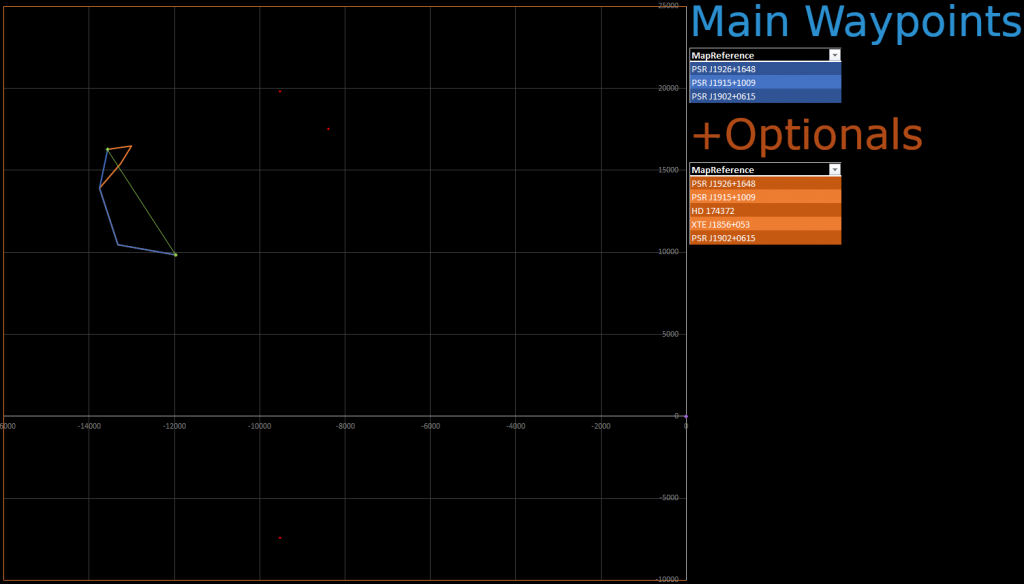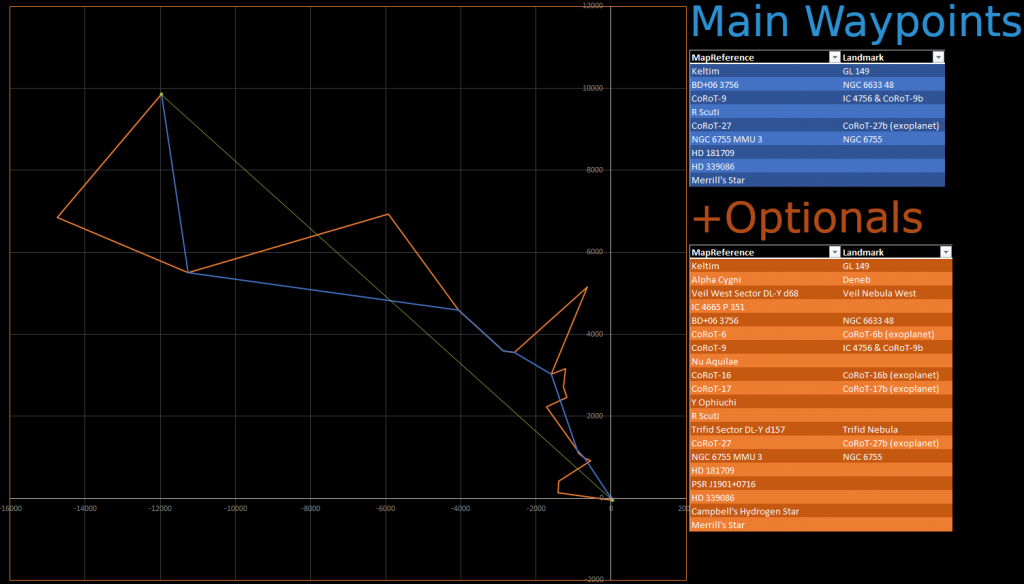It is now time for the third leg of Celebration of Early Astronomy, and this is the one that passes near Colonia for those interested in visiting it, or “getting out of the black” for a little bit.
Dates
Start Date: July 24, 2021
End Date: August 7, 2021
Distances
Basecamp Line: 17,474.22 Ly
Main Waypoints: 8,999.86 Ly
Optional Waypoints: 19,385.95 Ly
Map, (click for full size):

Basecamp: 15 Sagittarii
Main Waypoints
- Map References quick reference list, more details below
- XTE J1856+053
- PSR J1852+0031
- AXP 1E1841-045
- 15 Sagittarii
Main Waypoints Details
- Map Reference: XTE J1856+053
- POI: INTREF 948
- XTE J1856+053, also known as INTREF 948 is a transient X-Ray binary that was observed with higher than usual outbursts in 1996 and 2007.
- Extra Note: This was also included as an Optional Waypoint on Leg 2 as well, so you may have already visited this in Leg 2 possibly.
- Map Reference: PSR J1852+0031
- This is a pulsar discovered and studied by the Parkes Multibeam Pulsar Survey
- Map Reference: AXP 1E1841-045
- AXP 1E1841-045 is ananomalous x-ray pulsar , thought to be a magnetar, located within the Kes-73 supernova remnants.
- SIMBAD Link
- EDSM Link
- Map Reference: 15 Sagittarii
- 15 Sagittarii is a double-lined spectroscopic binary star system matching the profile of a massive O-type supergiant star. It ionizes the H II region along the western edge of the molecular cloud L291 along with an I-type star 16 Sagittarii (not in game)
- SIMBAD Link
Optional Waypoints
- Map References quick reference list, more details below
- XTE J1856+053
- V1343 Aquilae
- TT Aquilae
- PSR J1852+0031
- PSR J1905+0154A
- PSR J1905+0154B
- AXP 1E1841-045
- Far Tauri
- Tisdar’s Retreat
- 15 Sagittarii
Optional Waypoints Details
- Map Reference: V1343 Aquilae
- POI: SS 433
- SS 433, also known as V1343 Aquilae is the first ever discovered microquasar. It is an eclipsing X-ray binary system with the main star most likely a black hole and the spectrum of the companion star suggests it to be a late life A-type star. However there are speculations that the main star might actually be a neutron star and not a black hole.
- SIMBAD Link
- EDSM Link
- Map Reference: TT Aquilae
- TT Aquilae is a yellow-white supergiant Classical Cepheid Variable star in the Aquilae constellation. Classical Cepheid variable stars are young stars that exhibit radial pulsations with a periods between a few days to few weeks and visual amplitude fluctuations from a few tenths to up to 2 magnitudes worth.
- SIMBAD Link
- EDSM Link
- Map Reference: PSR J1905+0154A
- A pair of pulsars that are a double star, interestingly though in the in-game galaxy the two systems have the same exact coordinates.
- Map Reference: PSR J1905+0154B
- POI: V408 Vulpeculae
- A pair of pulsars that are a double star, interestingly though in the in-game galaxy the two systems have the same exact coordinates. This system has the star V408 Vulpeculae in it which is a Classical Cepheid Variable star discovered in 1898 at the Potsdam Observatory by Gustav Müller and Paul Kempf. A study in 1991 revealed that V408 Vulpeculae is a spectroscopic binary. In 1996 it was calculated that it has an orbital period of 2510 days with it’s binary companion star. It’s companion star is invisible from earth and is only known from its effect on the motion of V408 Vulpeculae.
- SIMBAD Link to PSR J1905+0154B
- SIMBAD Link to V408 Vulpeculae
- EDSM Link
- Map Reference: Far Tauri
- POI: (NBORO) Colonia Region
- Far Tauri is Simbad Regime’s Colonia faction’s main base within the Colonia region. If you have exploration data to sell at this point in the expedition, selling to the settlement Chaydar Correctional in this system would be appreciated!
- Map Reference: Tisdar’s Retreat
- POI: (NBORO) Tisdar’s Retreat
- This is a system that in patch 3.3.0.2 Frontier Developments renamed to Tisdar’s Retreat for some unspecified reason.



